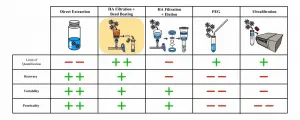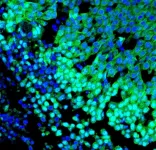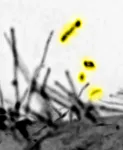Investigational gene regulation therapy could protect against Alzheimer's
2021-03-22
(Press-News.org) Researchers at the DZNE (Germany), at Massachusetts General Hospital (USA) and at the genomic medicine company Sangamo Therapeutics, Inc. tested a novel gene regulation approach to treat brain diseases such as Alzheimer's in laboratory studies. It leverages zinc finger proteins, which specifically bind to the DNA that codes for the protein Tau without altering it, thereby reducing Tau production in the brain and preventing nerve damage. The preclinical results, published in the journal Science Advances, could lay the foundation for new therapies.
The Tau protein plays a key role in the development of certain degenerative brain diseases called tauopathies. Tau accumulates and aggregates within nerve cells, causing destruction of synapses and cell death. The consequence is a progressive dysfunction of cognitive, motor and psychological abilities.
Results of new research published in the journal Science Advances demonstrate that a gene regulation therapy using zinc finger protein transcription factors (ZFP-TFs) provides sustained Tau protein reduction in the brain when administered to a preclinical mouse model of Alzheimer's disease, one of the most studied tauopathies. A one-time intravenous or intracranial administration of tau-targeted ZFP-TFs decreased tau levels by 50 to 80% out to 11 months, the longest time point studied. The zinc finger technology was developed by Sangamo Therapeutics and has now been applied by the researchers to reduce Tau protein in the adult brain.It could be the starting point for a new generation of treatments for tauopathies such as Alzheimer's disease and frontotemporal dementia.
Preclinical studies show high efficacy with no obvious side effects
According to Susanne Wegmann, head of a research group at the DZNE in Berlin, the results of the study, performed in adult mice, indicate that nerve cells appear to be protected against early toxic effects of amyloid-beta if Tau has been reduced by the Tau-targeted zinc finger proteins: "Under certain conditions, such as Alzheimer's disease, Tau proteins can have the effect of a cell toxin. Thus, there is an ongoing effort to reduce their amount in the brain," Wegmann explains. Nerve cell damage occurs first in the vicinity of amyloid plaques, which are, next to Tau, the other kind of protein accumulation found in Alzheimer's disease brains. Wegmann and colleagues were now able to prevent this by reducing Tau with this approach. "Nerve cells normally produce Tau proteins. With the help of zinc finger protein technology, we have now been able to achieve a long-lasting reduction of Tau production, and thereby significantly reduce the toxic effects of the plaques," Wegmann explains. Of additional importance is that the long-lasting Tau reduction did not cause obvious side effects or changes in tissue structure in the brains of treated mice. "In this publication, we demonstrate that ZFP-TFs can reduce Tau mRNA and proteins in neurons both acutely and long-term in the adult brain. With this, we can achieve a long-lasting effect upon a single injection of therapeutic adeno-associated viruses, with no obvious neurotoxic side effects," says Wegmann, DZNE researcher.
Zinc finger technology as a starting point for future therapies in humans
Zinc finger proteins can be engineered to bind very specifically to unique gene sequences within the cell and reduce or silence their expression. In this work, they were programmed to precisely bind to sequences in the genetic code for the Tau protein. Thus, the transcription of these sequences, and consequently the production of the Tau protein, is blocked; as a result, the total amount of Tau decreased by 50 to 80% throughout the brain. Unlike gene-editing approaches, which cut or change the DNA itself, ZFP-TFs induce long-term changes in Tau expression without altering the genetic material of the cells in the process.
The nerve cells do not produce the zinc finger protein naturally, but are made to do so with a biotechnological technique - by introducing the blueprint for this substance into the cells via an engineered virus. These AAVs cannot multiply or spread, and instead serve as a useful delivery mechanism for the ZFP-TF to reach its destination within the brain. The cell's natural machinery then continuously produces the ZFP-TF proteins - over a long period of time - to block the Tau gene. In this way, a single treatment is likely to be sufficient to reduce the Tau protein for the long term.
"These compelling results published in Science Advances demonstrate the potential of our highly specific and efficient zinc finger protein transcription factor technology for treating neurologic disease," said Bryan Zeitler, Director of Gene Regulation at Sangamo. "There are currently no disease-modifying thereapies approved for patients with Alzheimer's disease or other tauophathies. This publication represents the promise of Sangamo's zinc finger protein transcription factor approach to potentially provide a one-time treatment to slow or stop disease progression."
The results serve as basis for further development of the technology and for clinical research in humans. The pharmaceutical company Biogen has a global collaboration agreement with Sangamo to develop gene regulation therapies based on this approach and the Companies are progressing toward the clinic.
INFORMATION:
Original publication:
Persistent repression of tau in the brain using engineered zinc finger protein transcription factors
Susanne Wegmann et al., Science Advances (2021), DOI: 10.1126/sciadv.abe1611
WEB: https://advances.sciencemag.org/content/7/12/eabe1611
On the German Center for Neurodegenerative Diseases (DZNE)
The DZNE investigates all aspects of neurodegenerative diseases (such as Alzheimer's and Parkinson's diseases and Amyotrophic lateral sclerosis) in order to develop novel approaches of prevention, treatment, and health care. The DZNE is comprised of ten sites across Germany and cooperates closely with universities, university hospitals, and other institutions on a national and international level. The DZNE is a member of the Helmholtz Association. Website: http://www.dzne.de/en
ELSE PRESS RELEASES FROM THIS DATE:
2021-03-22
The efficacy of biosensors used in clinical tests depends critically on the surface of the device on which the biorecognition molecules are immobilized. This surface can be adjusted and sometimes controlled using self-assembled molecular monolayers as matrices. The monolayers are films made up of organic molecules that under the right conditions assemble spontaneously on metal surfaces via chemical bonds between the sulfur atoms and the metal.
A study conducted at the University of São Paulo's São Carlos Physics Institute (IFSC-USP) in Brazil compared the performances of two types of self-assembled ...
2021-03-22
Myelodysplastic syndrome (MDS) is a disease of the stem cells in the bone marrow, which disturbs the maturing and differentiation of blood cells. Annually, some 200 Finns are diagnosed with MDS, which can develop into acute leukaemia. Globally, the incidence of MDS is 4 cases per 100,000 person years.
To diagnose MDS, a bone marrow sample is needed to also investigate genetic changes in bone marrow cells. The syndrome is classified into groups to determine the nature of the disorder in more detail.
In the study conducted at the University of Helsinki, microscopic images of MDS patients' bone marrow samples were examined utilising an image analysis technique based ...
2021-03-22
Greenwood, SC (March 22, 2021) - A research team at the Greenwood Genetic Center (GGC) has identified the mechanism that causes movement disorders in patients with mutations in the NUS1 gene. Using both cellular and model organism studies, cholesterol accumulation was found to contribute to the symptoms of seizures, ataxia, and movement abnormalities. This breakthrough study on NUS1, a gene that has also been potentially linked to Parkinson's Disease, is reported in the current issue of Genetics in Medicine, the Journal of the American College of Medical Genetics and Genomics.
Chloe Murphy, 15, of Bluffton, SC began experiencing tremors at age three. Through the years she has also experienced seizures, atypical eye movements, learning delays, ...
2021-03-22
Reston, VA--A new treatment for late-stage neuroendocrine tumors (NETs) has been found to be more effective and have fewer side effects than the current standard of care, according to research published in the March issue of The Journal of Nuclear Medicine. The novel peptide receptor radionuclide therapy holds promise to reduce mortality among NET patients and decrease the financial burden of their continual treatment.
NETs are a diverse group of tumors that originate from the neuroendocrine system, which is responsible for regulating hormones throughout the body. The number of people who are diagnosed with NETs is growing; the incidence of NETs increased 6.4-fold from 1973 to 2012. However, because they are rare, varied, ...
2021-03-22
HOUSTON - (March 22, 2021) - There are many ways to test municipal wastewater for signs of the virus that causes COVID-19, but scientists in Houston have determined theirs is the best yet.
A study led by environmental engineer Lauren Stadler of Rice University's Brown School of Engineering with the aid of the City of Houston Health Department and Baylor College of Medicine compared five processes used by labs around the country to concentrate samples and find the virus in wastewater from six Houston plants.
The process employed at Rice and now Baylor, called "electronegative filtration with bead beating," proved the most sensitive to signs of the virus as well as the most cost-effective.
The study appears in the Elsevier journal Water Research.
There ...
2021-03-22
Breast cancer is the most common type of tumour found in women. 69,000 new cases are diagnosed each year in Germany alone. Around 80 percent of tumours originate in the luminal cells, the milk-producing cells of the mammary gland. 10 percent of the cells resemble those of the underlying (basal) cell layer. These are muscle-like epithelial cells that contract when the mammary gland produces milk in order to push it out.
"While luminal breast tumours are usually sensitive to hormones, 80 percent of basal-like tumours are triple-negative. They have no receptors ...
2021-03-22
Scientists from the University of Leeds's Nutritional Epidemiology Group used data from 500,000 people, discovering that consuming a 25g serving of processed meat a day, the equivalent to one rasher of bacon, is associated with a 44% increased risk of developing the disease.
But their findings also show eating some unprocessed red meat, such as beef, pork or veal, could be protective, as people who consumed 50g a day were 19% less likely to develop dementia.
The researchers were exploring a potential link between consumption of meat and the development of dementia, a health condition that affects 5%-8% of over 60s worldwide.
Their results, titled Meat consumption and risk of incident dementia: cohort study of 493888 UK Biobank participants, ...
2021-03-22
Ikoma, Japan - What if you found out that you could heal using only a finger? It sounds like science fiction, reminiscent of the 1982 movie E.T. Well, it turns out that your body's own cells can do something similarly unexpected. Researchers at Nara Institute of Science and Technology (NAIST) report in a new study seen in Developmental Cell a means by which cells may use "fingers" to communicate instructions for wound closure.
NAIST project leader Shiro Suetsugu has devoted his career to studying how cells shape themselves, initiate and accept communication among one other. An under-appreciated means of doing so is through filopodia, small finger-like ...
2021-03-22
WHAT:
Children in high-poverty neighborhoods who participated in a comprehensive preschool program that provided parents with health and educational services and job training had a lower body mass index (BMI) in their late 30s than a similar group who participated in the usual early childhood programs, according to a study funded by the National Institutes of Health. The study authors concluded that comprehensive, school-based early childhood programs could lead to improvements in body mass index later in life. The study was conducted by Arthur J. Reynolds, Ph.D., of the University of Minnesota, and colleagues. It appears in JAMA Pediatrics. ...
2021-03-22
What The Study Did: This study examined whether the quantity and quality of antibodies against SARS-CoV-2 were different among children, adolescents and young adults.
Authors: Zhen Zhao, Ph.D., of Weill Cornell Medicine in New York, is the corresponding author.
To access the embargoed study: Visit our For The Media website at this link https://media.jamanetwork.com/
(doi:10.1001/jamanetworkopen.2021.4302)
Editor's Note: The article includes conflict of interest and funding support disclosures. Please see the article for additional information, including other authors, author contributions and affiliations, conflict of interest and financial disclosures, and funding and support.
INFORMATION:
Media ...
LAST 30 PRESS RELEASES:
[Press-News.org] Investigational gene regulation therapy could protect against Alzheimer's




